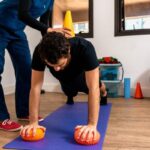Gymnastics is more than just flips and routines—it’s an art form that combines strength, flexibility, discipline, and grace. For anyone wondering how to learn gymnastics, the journey begins not with a leap but with a step. Whether you’re a child with big Olympic dreams or an adult seeking a new challenge, understanding the foundational aspects of gymnastics can pave the way for steady and fulfilling progress.
Discovering the Passion for Gymnastics
Learning gymnastics starts with a spark of interest. Perhaps it’s the awe of watching elite athletes soar through the air or the desire to improve personal strength and flexibility. Whatever the reason, developing a genuine passion is the first milestone. That passion fuels persistence, which is essential, because gymnastics requires time, patience, and consistent effort to master.
Enthusiasm for gymnastics also involves familiarizing oneself with the various disciplines. From artistic gymnastics and rhythmic routines to trampoline and acrobatic gymnastics, each offers a unique blend of skills and expression. While beginners often start with artistic gymnastics, exploring all disciplines helps tailor the learning path to individual interests and strengths.
Preparing Mentally and Physically
Understanding how to learn gymnastics involves preparing both body and mind. Gymnastics demands physical agility, but mental strength is just as crucial. A positive mindset enables learners to tackle fears, overcome mistakes, and stay committed during challenging moments.
Physically, it is important to begin with basic fitness. Stretching regularly improves flexibility, while core and upper body workouts enhance the strength necessary for skills like handstands and cartwheels. Building a strong foundation before diving into techniques reduces the risk of injury and creates confidence in movement.
Equally vital is the mental preparation to accept gradual progress. In gymnastics, mastery doesn’t happen overnight. Learning to be patient, setting realistic expectations, and celebrating small victories builds resilience and keeps motivation high.
Choosing the Right Training Environment
The training environment plays a significant role in how effectively one learns gymnastics. Whether it’s a community center, a specialized gym, or even a home practice space, the surroundings must be safe, supportive, and well-equipped.
For beginners, joining a structured class led by certified coaches offers numerous benefits. Professional guidance ensures proper technique, tailored progression, and essential feedback. Coaches also help instill discipline and accountability—two core values in gymnastics.
Additionally, a positive and encouraging atmosphere contributes immensely to the learning experience. Being surrounded by others who share similar goals fosters camaraderie and inspiration, while a supportive coach helps boost confidence and ensure steady development.
Understanding the Basics Before Advancing
When it comes to how to learn gymnastics, skipping the basics is never a good idea. Foundational skills such as forward rolls, splits, bridges, and basic jumps form the core of more complex maneuvers. Learning these properly establishes muscle memory and teaches essential body awareness.
A common misconception is that gymnastics is all about high-level tricks. In reality, every impressive flip or aerial movement builds upon a simple technique refined through repetition. By focusing on posture, control, and transitions, students develop the coordination and stability needed for more advanced skills later on.
Progress in gymnastics is methodical. It often begins with floor exercises, moves on to apparatus like the balance beam or bars, and gradually expands as confidence and strength improve. Embracing this progression ensures safety and solid long-term development.
Investing in the Right Gear
Learning gymnastics isn’t only about training—it’s also about having the appropriate gear. Comfortable, fitted clothing allows freedom of movement without the risk of snagging or slipping. Leotards are a popular choice for their flexibility and function, especially in formal training settings.
For home practice, a good-quality mat is a must. It provides cushioning to reduce impact and protect joints during exercises. Some learners may also benefit from soft blocks or bars designed for beginners to safely practice skills like pullovers or backbends.
Shoes are generally not required for gymnastics, as practicing barefoot enhances balance and grip. However, certain routines, such as rhythmic gymnastics or trampoline, may involve specialized footwear depending on the surface or apparatus used.
Building Consistency Through Practice
Consistency is the heartbeat of gymnastics training. Regular practice reinforces technique, builds strength, and sharpens focus. It’s not uncommon for beginners to feel overwhelmed, especially when progress seems slow. However, sticking to a schedule—even with short daily sessions—creates a rhythm that leads to steady improvement.
In learning how to learn gymnastics, tracking personal progress can be incredibly motivating. Maintaining a training journal, recording videos, or simply noting skill achievements each week allows learners to reflect on how far they’ve come. This habit not only highlights success but also reveals areas that need more attention.
Furthermore, maintaining variety in routines keeps training enjoyable. Rotating between different skills, drills, and apparatus helps prevent burnout and ensures a well-rounded approach to development.
Staying Safe and Avoiding Injury
Safety in gymnastics is non-negotiable. While the sport can be thrilling, it also carries inherent risks if not approached properly. Beginners must learn how to fall safely, warm up thoroughly, and listen to their bodies during training.
Coaches and gyms typically implement safety protocols such as proper spotting, crash mats, and progression plans. However, personal responsibility also plays a role. Rest and recovery are as important as training itself, especially when pushing physical limits.
Nutrition and hydration also contribute to safe learning. A balanced diet supports muscle growth and energy levels, while staying hydrated ensures focus and reduces the likelihood of cramps or fatigue during intense sessions.
Setting Goals and Staying Motivated
Learning gymnastics is a journey best traveled with clear goals. These goals can range from mastering a handstand to performing a complete routine. Setting short-term and long-term goals provides direction, and checking them off as they’re achieved builds momentum.
Motivation sometimes wanes, particularly when progress stalls or injuries occur. This is where having a support system—coaches, peers, family—can make a difference. Encouragement and guidance help learners push through difficult phases and continue their journey with enthusiasm.
In addition to external support, self-motivation matters. Visualizing success, watching performances by elite gymnasts, and revisiting personal goals all serve to reignite the drive to improve.
Embracing the Gymnastics Lifestyle
Once someone understands how to learn gymnastics, it becomes more than just a sport—it becomes a lifestyle. The discipline, balance, and focus developed through gymnastics extend far beyond the gym. These qualities enhance academic performance, social interactions, and personal well-being.
Moreover, gymnastics fosters a unique sense of self-awareness. Learners gain a deeper understanding of their bodies, abilities, and limits. This awareness nurtures confidence and empowers individuals to take on new challenges with courage and determination.
From recreational practice to competitive aspirations, the values cultivated through gymnastics—perseverance, dedication, and grace under pressure—remain invaluable life skills.
Conclusion: The Rewarding Journey of Learning Gymnastics
For those eager to explore how to learn gymnastics, the path ahead promises both challenges and rewards. Starting with a spark of interest, building physical and mental readiness, and committing to consistent, safe training form the pillars of success in this dynamic sport.
Whether the goal is to perform a perfect cartwheel or pursue competitive excellence, gymnastics offers an enriching experience that sharpens the body and uplifts the spirit. With the right mindset, guidance, and environment, anyone can embark on this journey and discover the strength, flexibility, and joy that lie within the world of gymnastics.





